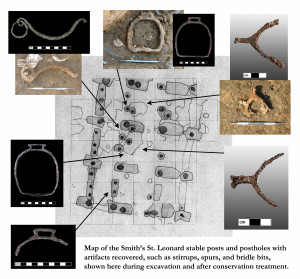
Jefferson Patterson Park & Museum
Equine Artifacts and Natural Beauty
10515 Mackall Road, St. Leonard, MD
Visit the website
VIEW ON MAP | GET DRIVING DIRECTIONS | Follow on Facebook
A stunning view of the Patuxent River, plus a glimpse into the history of horses who once lived here combine to make a trip to Jefferson Patterson Park & Museum (JPPM) a truly unique experience.
Rural horse stables dating to the early 18th century are practically nonexistent today in the Chesapeake region, and even the historical documentation on these structures is fairly scant. So the discovery of a stable at the Smith’s St. Leonard Plantation Site (occupied c. 1711-1754) at JPPM has been exciting for architectural historians and archaeologists alike. The building measured 24 feet by 40 feet, and had a 10-foot-wide central passageway flanked by eight stalls, each seven feet wide. The dirt floors of the stalls sloped down to the center of the structure, so they could be more easily mucked out. Small posts throughout the stable probably supported feeding troughs, gates, etc.
Numerous horse-related artifacts, including stirrups, spurs and bridle bits, were recovered here. Archaeology  is still ongoing at the Smith’s St. Leonard site, but the stable will be a focus of public interpretation on JPPM’s Riverside Interpretive Trails and Exhibit Stations (RITES) Trail, currently in development.
is still ongoing at the Smith’s St. Leonard site, but the stable will be a focus of public interpretation on JPPM’s Riverside Interpretive Trails and Exhibit Stations (RITES) Trail, currently in development.
Other horse-related artifacts from across the state, including the remains of a decorated leather saddle excavated from a mid-18th-century well in Oxon Hill, can be seen at the Visitor Center and during tours of JPPM’s Maryland Archaeological Conservation Laboratory. And at JPPM’s Exhibit Barn, there are examples of antique horse-drawn agricultural equipment on display.
JPPM covers a 560-acre site in St. Leonard, and is listed on the National Register of Historic Places as an archaeological district with more than 65 identified archaeological sites evidencing more than 9,000 years of human activity on the property. It is also the home of the Maryland Archaeological Conservation Laboratory (MAC Lab), which houses over 8 million artifacts. Visitors can hike miles of trails, explore interactive exhibits, enjoy educational programs and events, or just enjoy the beautiful setting on the banks of the Patuxent River. Find more info on the JPPM website.
Photos courtesy of Jefferson Patterson Park & Museum unless otherwise noted.